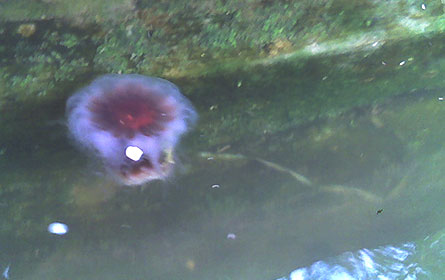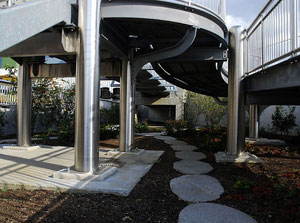Staten Island's Toxic Stew
A week after we posted this article, Melissa Checker learned of another perhaps even mrore serious toxic threat on Staten Island. A former warehouse on the North Shore played a significant part in the Manhattan Project, leaving behind levels of uranium contamination nearly 10 times higher than allowable standards in some places. Read her Wonkster post on this development.
This spring, residents of Staten Island's North Shore received news of a triple toxic whammy. First, on March 23, 300 gallons of oil spilled during a ship-to-ship transfer near the St. George ferry terminal. Then, on April 2, the federal Environmental Protection Agency announced that it found lead levels up to 10 times higher than acceptable on the site of a former Sedutto's ice cream factory, just steps away from several homes. That same night, the agency stated that it found elevated levels of lead and arsenic at nearby Veterans Park.
These events mark only the tip of a highly toxic iceberg threatening Staten Island's North Shore. An area of approximately 5.2 square miles, the North Shore contains approximately 21 sites that the Environmental Protection Agency or residents have identified as contaminated. All of them sit within 70 feet of homes and apartment buildings, and residents believe that many violate state environmental regulations. For Beryl Thurman, president of the North Shore Waterfront Conservancy, the industrial zone free-for-all "is like a Girls Gone Wild video."
Yet, the North Shore's toxic woes remain a dirty New York City secret. While Staten Island's most famous waste site, Fresh Kills, once the world's largest landfill, has received abundant attention in recent years, the media has largely ignored Staten Island's other toxic sites. North Shore residents find that they must fight to have their voices heard by state and local officials. Thurman believes it comes down to demographics. The North Shore has the borough's lowest household income, and 48 percent of its households are black or Hispanic. We are "a low-income community of color... If Staten Island is the 'forgotten borough' then on the food chain, we're way down low," Thurman said.
A visit to the North Shore dramatically illustrates the area's uneasy mix of residences and industry. A public pool perched on a hill above the harbor offers a view of garbage-loaded barges. Just west of the pool, an enormous mound of road salt housed at the nearby Atlantic Salt Co. rises high into the sky. Streets feature rows of 19th century shotgun houses side-by-side with notoriously noxious neighbors like a city Department of Sanitation garage, an auto demolition company and a waste transfer station, to name a few.
Residents also fear the specter of past industries. Before it was Sedutto's, the ice cream factory site housed a succession of lead companies. Other former facilities produced gypsum, railway freight cars, boats, ships and linseed oil. The remnants of the chemicals used haunt North Shore residents, who fear that the substances might leach into groundwater and circulate through the air, threatening public health.
They have reason to worry. According to the American Lung Association, Staten Island has the worst smog of any of the five boroughs, and the New York State Department of Health reports that the death rate from lung cancer on Staten Island is 48 percent higher than for the rest of New York City. Thurman herself was diagnosed with asthma in her early 40s. "It wasn't something that was in my family or that I had as a kid," she remembered. According to Thurman, many North Shore residents have developed rare forms of cancer.
Residents hope that remediation of the Sedutto's site will spur a larger effort to give all of the North Shore's toxic areas the attention they deserve. "A lead contaminated site in a residential area would not be tolerated in Brooklyn or Manhattan," said U.S. Rep. Michael McMahon, who represents the area. "We have a number of potentially toxic sites on Staten Island, and it is time to remediate them."
A Toxic Legacy
In stark contrast to its present state, until the late 1800s, Staten Island's North Shore served as a resort area for New York's hoi polloi. However, as the industrial revolution overtook New York, Staten Island's waterways became integral to the city's growing economy, and industries proliferated along the North Shore. By the turn of the 20th century, the area had become Staten Island's most densely populated in terms of industry and people.
It was not until the passing of zoning laws in 1961 that the city undertook a serious effort to limit the degree to which industries and residences could cohabitate. At that time, the city zoned almost half of Staten Island's waterfront, including all of the North Shore, for industrial use. New residences had to have buffers to protect them from certain kinds of industries, but the city permitted all existing industrial properties and residences to remain as they were.
Today, that mix continues. At present, the North Shore houses two private waste transfer stations, an abundance of salvage yards, a Department of Sanitation garage, a Con Edison plant, an Metropolitan Transportation Authority bus depot, a private luxury coach depot and a New York City Department of Environmental Protection sewer treatment plant. Many of these facilities have replaced older and even more noxious industries, but some require the use of oversized trucks, which frequently travel on local streets. That truck traffic contributes to the borough's overall poor air quality.
Hazardous Waters?
Bordering all of these sites is the tidal strait known as the Kill Van Kull. Every year, hundreds of cargo ships and tankers pass through the kull, which is zoned for industrial use. Fuel lines connecting New York and New Jersey run under the water. Some experts estimate that over 300 oil spills occur in the kull every year from the fuel lines and from ship transfers like the one in March. While the Coast Guard was able to clean up most of the March spill, the guard also has promised to step up its enforcement on spills in the Kill Van Kull, as well as illegal dumping.
Under New York law, waterfront industries must comply with the State Pollutant Discharge Elimination System to control discharges into waterways and groundwater. Local environmentalists, such as Jim Scarcella of the Natural Resources Protective Association, worry that because the regulation relies on factories and other sources to report any discharges themselves, facilities along the kull "might not be in compliance."
Portions of the Kill Van Kull are part of the Diamond Alkali Superfund Site, which includes the lower Passaic River and parts of the Newark Bay. According to the Environmental Protection Agency, these bodies of water contain dioxin, PCBs, mercury, DDT, pesticides and heavy metals from various companies that once manufactured pesticides -- including those used to make Agent Orange -- along the Newark Shore.
Local environmentalists fear the situation could get worse. Ongoing dredging by the Army Corps of Engineers and private waterfront industries could unearth those contaminants. In 2005, the Natural Resources Defense Council, NY/NJ Baykeeper and GreenFaith filed a successful lawsuit to stop the Army Corps of Engineers from dredging the kull. In a settlement, the Corps of Engineers agreed to adopt stricter environmental safety measures. Today, however, dredging continues near the Bayonne Bridge, adding noise to North Shore residents' long lists of pollution complaints.

For obvious reasons, the New York State Department of Health distributes fishing advisories throughout the North Shore warning people not to eat locally caught fish. Yet, subsistence fishing continues. For years, the North Shore Waterfront Conservancy has requested that either the Department of Environmental Conservation or the state health department place hazard signs at popular fishing areas, to no avail. "It's about liability and jurisdiction," Thurman suspects.
A Bittersweet Victory
The Sedutto's site represents a prime example of the North Shore's combination of past and present toxic threats. Its history with lead production made it a candidate for the federal Superfund program, which was enacted to clean up toxic sites. However, according to an Environmental Protection Agency spokesperson, the government team sent to inspect the area in the early 1980s had an incorrect address. Unable to find the property, the agency closed the case.
For the next two decades, Sedutto's sold and re-bought the site several times. By the late 1990s, the ice cream plant was no longer operating and the property sat vacant until Perfetto Construction purchased it in 2007. Last April Thurman noticed that Perfetto was using the site to store equipment and debris from a nearby sewer construction project.
"There's all this dust and dirt flying around on everything. So, I'm on the phone with the [New York State Department of Environmental Conservation] and the EPA going, 'what are you doing to protect the residents whose homes are right here?'" she said. Thurman also contacted her then City Council member, McMahon. Eventually, her efforts paid off -- the Department of Environmental Conservation issued a stop work order, and McMahon helped pressure the federal Environmental Protection Agency to re-open its investigation. The agency then discovered the elevated lead levels.
Upon making its April 2 announcement, the Environmental Protection Agency began initial remediation. The agency asked Perfetto to install silt fencing and hay bales around the site's perimeter to prevent migration of the lead, and is "evaluating further steps to be taken," according to a government spokesperson. Meanwhile, McMahon's office has coordinated with the Community Health Center of Richmond and the Beacon Christian Community Health Center to offer free lead testing to area residents.
The lead and arsenic contamination over at Veterans Park is unrelated to the Sedutto's site, according to an Environmental Protection Agency spokesperson. Rather, the agency traces the toxins there to the past use of pesticides by the Parks Department. Officials also maintain that contaminant levels are relatively insignificant -- lead is considered hazardous at 400 parts per million and was found at 516 parts per million one foot below the surface of the park. The hazardous threshold for arsenic is 16 parts per million. At Veterans Park, levels were discovered at 1.4 to 81.5 parts per million.
To protect park users, the agency has covered the ground with woodchips to contain any toxins that might surface. But community members continue to worry about the safety of the park, which remains under the jurisdiction of the city Department of Parks and Recreation. Local families use the park, mainly a grassy field, for picnicking, playing soccer, mini football and baseball games. As Thurman points out, "kids are throwing [the] mulch in each other's faces."
Community groups including North Shore Waterfront Conservancy and the Port Richmond Improvement Association and the local business organization, the Port Richmond Board of Trade, want the city to close the park and complete further remediation.
Since the April meeting, they also have asked the department to post warning signs around the park to no avail. In early May, residents took matters into their own hands and placed two 4-by-8 foot bilingual signs at the park. A few days later, the parks department removed them. "While we understand the community's concern, we cannot allow unauthorized signs on parks property," spokeswoman Meghan Lalor told the Staten Island Advance.
Other community requests for action have met with less dramatic but similarly limited results. For instance, residents asked to relocate two transit authority bus stops near the former Sedutto's site and requested more prominent signs warning of possible hazards there. They also want the Environmental Protection Agency to test nearby Faber Park for contamination.
Local Actions
Since its inception in 2001, the North Shore Waterfront Conservancy has been a persistent voice for environmental justice on the North Shore. For instance, in addition to campaigning to get the former Sedutto's site tested, Thurman, who recently won a 2009 EPA Environmental Quality Award for Individual Citizens, repeatedly calls the state Department of Environmental Protection to complain that the sewer treatment plant "stinks to high heaven" and needs a major upgrade.
The conservancy also sponsors ecotours and regular garbage cleanups of public spaces along the waterfront in order to educate community members about environmental and health issues. In another ongoing project, the groups are gathering a database of potentially contaminated sites that details their present and former uses, the chemicals involved in those uses and the health risks they present. Finally, it advocates for sustainable economic development along the waterfront, which would ensure existing businesses reduce emissions and bring in new, environmentally friendly business.
The last objective is shared by the Staten Island Economic Development Corp., which recently launched an effort to establish a Green Enterprise Trade Zone on Staten Island. The zone idea dovetails with many initiatives in Mayor Michael Bloomberg's PlaNYC 2030.
The North Shore Waterfront Conservancy supports such plans as long as they don't lead to gentrification and the displacement of North Shore residents, according to Thurman. She has reason to be wary -- the development corporation, along with City Councilmember James Oddo's office, held a "Staten Island Health and Environmental 2009" conference in September. They invited representatives from green-tech industries but neglected to reach out to conservancy or other local environmental groups.
For now, though, North Shore residents have focused their attention primarily on the more immediate future of the former Sedutto's site and Veterans Park. The Environmental Protection Agency plans to hold a public meeting in early June to discuss lead threats in the community. Meanwhile, North Shore residents and their advocates continue to pressure the agency, as well as its state and local counterparts, to clean up their acts.
"The general thing is to make the waterfront and the waterfront communities safe," states Thurman, "The way people are treated in those communities right now it's like because... you are in a certain income status, it's your lot in life that you suffer."
Melissa Checker is assistant professor of urban studies at Queens College, City University of New York. She is the author of Polluted Promises: Environmental Racism and the Search for Justice in a Southern Town.
The Brooklyn-Queens Border: As Polluted as Ever
Pewter-colored water lapped up onto the bottom concrete step of an industrially inspired public park on the bank of Newtown Creek.
Amid the new plantings and tall grass, a middle-aged man chased his tawny, rather stout canine around the concrete landscape -- one of the only access areas along the estuarine waterway.
He kept his dog away from the water's edge. And any passersby would likely do the same.
With an oil spill that carries its namesake and a putrid stench known to inspire headaches, Newtown Creek is the product of decades of oil refining, concrete crunching and trash condensing. The long-defunct oil mammoth, Standard Oil, called its shores home, and now so do its contemporaries, Exxon Mobil, Chevron and BP. These giants -- and many others, say advocates -- have helped make Newtown Creek one of the country's most polluted waterways.
For decades, residents and environmental advocates have been pushing for the federal government to clean up the creek, which divides Brooklyn and Queens, but to no avail. Now with the Gowanus Canal under consideration as a federal Superfund site -- a designation made by the U.S. Environmental Protection Agency -- and the area's legislators on board, including Rep. Anthony Weiner and Rep. Nydia Velazquez, advocates hope that Newtown Creek will finally get its cleanup.
How It Got So Dirty?
Members of the Newtown Creek Alliance are probably the waterway's biggest champions.
Strolling the creek's Nature Walk, a small public walkway adjacent to the area's wastewater treatment facility, alliance members Michael Heimbinder, Laura Hofmann and Kate Zidar take in the less than picturesque view and the stench wafting from the stagnant channel with surprising pleasure.
Across the way, forming the start of Queens County, they spot the delivery truck parking lot for Fresh Direct. Next door towers of crumpled cars sit on a large barge most likely belonging to waste management company Hugo Neu.
"This neighborhood was pretty much the backyard of the industrial revolution," said Zidar, while, at her feet, a bright pink Clorox label floats by.
That industry, which may have lifted a country, deluged Newtown Creek with oil, chemicals and toxins.
The oil industry's history in the Greenpoint area dates back to the 1800s. During the 1870s, more than 50 oil refineries were located along the banks of the creek, according to the Environmental Protection Agency. Between that time and the 1960s, Newtown Creek was a virtual oil refinery shopping mall -- all the heavy hitters were there, from Chevron to Mobil, now Exxon Mobil.
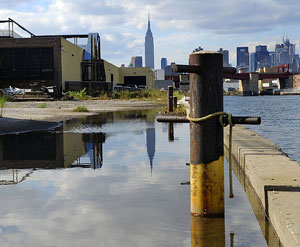
In 1978, during a routine helicopter flyover, the U. S. Coast Guard noticed an oil slick at the mouth of the creek, which meets the East River. That observation has today amounted to an oil spill, which released between 17 million and 30 million gallons into the creek, according to the Environmental Protection Agency. It is unclear, the agency says, whether the spill occurred over time -- a petroleum leak from companies' pipes that produced a pool of oil on the creek's floor -- or if it was one single and totally unnoticed event.
The Environmental Protection Agency also reports it is unclear which companies are wholly responsible -- though many name Exxon, Standard Oil's successor, as the primary offender.
Since that discovery, several companies have had "product recovery operations" around the site. Currently, there are no longer refinery operations on the creek. Exxon and Texaco operate recovery operations, and BP has a recovery and storage facility there.
In 1990, the oil companies and the state Department of Environmental Conservation reached an agreement to remove the petroleum, but critics allege its enforcement has been inadequate. According to the state, that effort has removed 10 million gallons of "petroleum product" from Newtown Creek.
Because of the spill, at least two lawsuits have emerged -- one from a number of Greenpoint residents and environmental advocacy group Riverkeeper and another from Attorney General Andrew Cuomo. The Riverkeeper suit is against Exxon, BP and Chevron, while Cuomo has targeted Exxon only. Both hope to spur a faster and more widespread cleanup of the creek.
The Health Cost
Possible health effects from the oil spill are not completely clear either. In 2007, the state tested some of the homes near the spill area for chemical vapors and determined that it was unlikely such contamination had occurred. Though the vast majority of either side of Newtown Creek is industrial, community advocates and officials fear the toxins may have leaked through the ground to homes less than a half-mile away.
The state has found, however, increased levels of methane, benzene, and other petroleum related compounds in commercial and industrial buildings within the neighborhood.
Some advocates disagree that the centuries worth of industry and production didn’t affect the health of the area's residents.
"My family's medical history reads like an Area 51 report," said Hofmann, who has lived in the neighborhood her entire life.
Hofmann, who is a plaintiff in the Riverkeeper lawsuit, says her whole family has been afflicted by an array of rare ailments and diseases -- from brain cancer to congenital spherocytosis, a type of anemia.
"The cumulative effects of everything are so far beyond anything we know, it's criminal," said Zidar.
The Work to be Done
Next to the former Standard Oil site, members of the alliance climb onto a protruding slab of cement to point out some of Exxon's "product capture" methods.
The water is stagnant, except for the small waves made by a passing boat named "Donna M" (most likely connected to an adjacent company), and the putrid smell forces alliance members to shroud their noses with their shirts.
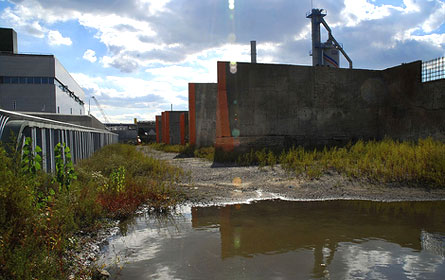
"Too bad you can't photograph that smell," quipped Hofmann. "You need a scratch and sniff for that."
Everyone laughs.
On the left bank, what looks like a plastic buoy lies across the water, creating a horseshoe-like loop against the creek's edge. That, said alliance members, is part of what the area's oil companies use to keep in their product.
Several feet away, a large pipe bursts out of the bank, spitting out gallons of brownish water. That, they explain, is the outfall, which pours the treated water back into the creek. You can smell the petroleum elements, Heimbinder says.
In 20 years, little has been done to clean up the creek, advocates allege. Unlike the Gowanus, the entire Newtown Creek area is filled with manufacturing or other industries. If no one lives nearby, advocates say, any remediation is "out of site, out of mind."
Hence, the need for the federal government to step in, they say. If Newtown Creek were designated a Superfund site, the Environmental Protection Agency would take over the site's remediation. The agency would seek out responsible parties, and sue them to get funding for the cleanup, which would most likely include dredging the 3.5-mile stretch of channel.
If they lose these cases, they are committed to cleaning up the site with federal dollars. At the behest of the state Department of Environmental Conservation and former Sen. Hillary Clinton and Congress members Velazquez and Weiner, the Environmental Protection Agency started testing the water in January. It finished sampling last month and is currently analyzing the results, a spokesperson said.
The agency releases two sets of Superfund sites per year. Elizabeth Totman, an agency spokesperson, said the agency was not ready to release the results from the creek's testing. The agency would be releasing another set of potential Superfund site designees later this year -- maybe the creek will be one of them.
There are approximately 10 state designated Superfund sites near the Brooklyn banks of the creek, accounting for 36 percent of the state sites in the county.
In response to a request for comment, a Bloomberg administration spokesperson said: "The city hasn't yet taken a position on the potential Superfund designation of Newtown Creek. We’re doing internal analysis now and plan to meet with the EPA next month before expressing any view. The city plans to invest nearly $1.9 billion in Newtown Creek related projects over the next decade."
Not Just Oil
The area's longstanding oil refineries are not the only ones to blame for the creek's noxious state.
The city too could be named a responsible party if the creek were designated a Superfund site. Like the Gowanus, the creek falls victim to the city's combined sewer overflow system, which covers about 65 percent of the city.
Heavy rainfalls overwhelm our sewage treatment system, forcing millions of gallons of raw sewage to pour out into our waterways annually. Newtown Creek is an incredibly stagnant body of water, which leaves our trash and feces floating throughout it.
Standing at a combined sewer outfall at the far end of one of the creek's tributaries, Zidar, who is also a founding member of the Storm Water Infrastructure Matters Coalition, explains that this one particular site deluges the creek with 288 million gallons of water a year -- ranking number 25 out of 400 in the city.
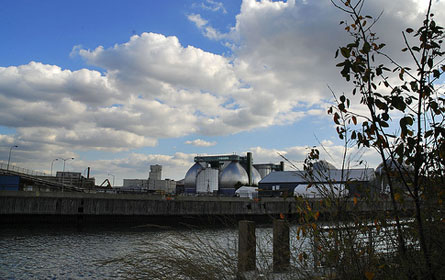
The water doesn't move, she says with the creek's bank serving as her backdrop -- one could spot the remnants of a four-door car half in and half out of the water. Sewage then, she adds, just mixes into the creek.
"The dilution is the solution doesn't apply here," said Zidar.
Because the city's stormwater system is so vast, it would be impossible -- or incredibly expensive -- to reconstruct in its entirety. The city is in the process of implementing a number of policies to divert stormwater or capture it and release it slowly following a rainfall, but advocates question how much of an impact that will have.
A Long Waterway Ahead
There is a reason why Superfund sites are controversial. For one, litigation can take decades to settle. After 25 years, dredging on the Hudson River, a Superfund site, started just this month.
Advocates also wonder how dredging certain areas of the creek, effectively cutting off access to its use, would affect the area's industry, which still uses the waterway. The city's garbage carriers use Newtown Creek to carry our waste to out of state landfills and incinerators.
By and large, advocates and Greenpoint residents and representatives want something done. Bernie Ente, an alliance member and Maspeth resident, was touring the area in his large Suburban last week. He may attribute 20 years passing without the drive for a cleanup to a possible lack of grievance.
"It's just the neighbors to the right don't complain a lot," Ente said. Then he pointed to Calvary Cemetery.
Cleaning Up Pollution at New York's Ports
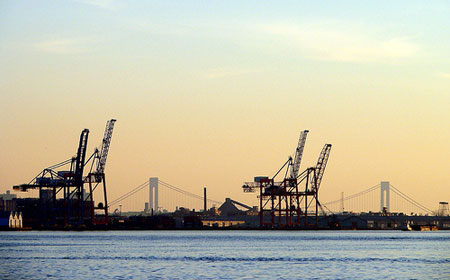
Our region depends on international shipping to maintain our daily habits and our long-term economic growth. Every day, huge ships bring goods from around the world to the Port of New York and New Jersey. Once these ships dock, cranes and other cargo-handling equipment unload the containers -- putting our clothes, toys, food, and other goods on diesel locomotives and trucks that carry them throughout the region.
These ships bring us what we want and what we need, when and where we want it. But they also bring us pollution that unnecessarily threatens the health of millions of New Yorkers who live near or downwind from our ports. Few ships (if any) are equipped with even the most basic pollution controls, and they typically burn a fuel that contains more than 2,000 times as much sulfur as a New York City Transit bus. Their smokestacks spew tons of particulate matter that trigger asthma attacks, cancers and thousands of premature deaths across the nation every year.
The pollution impacts of our region's port facilities are not limited to the ships in New York Harbor. The armada of cranes, cargo-handling equipment, locomotives, and trucks that ferry containers and their contents to every corner of the city and the region all use diesel-powered engines. Most operate without the most up-to-date pollution-cutting equipment.
Given that the Port of New York and New Jersey is the largest port on the East Coast, the third largest port in the nation and one of the 10 largest ports in the world, cleaning up port-related pollution must be a key part of the path to clean air and long-term sustainability in New York City.
Both the U.S. Environmental Protection Agency and the Port Authority of New York and New Jersey are taking this challenge seriously and are taking steps to clean up the delivery of goods into our region.
EPA Takes Action
On March 30, the U.S. Environmental Protection Agency announced a new proposal to reduce ship pollution within 200 miles of U.S. shores. When this new policy is fully implemented, it will have significant public health benefits in port communities and throughout New York, given that ship emissions can travel downwind for hundreds of miles.
Under the agency's proposal, all U.S. and foreign ocean-going vessels in the so-called "Emission Control Area" (within 200 miles of New York Harbor and almost all U.S. shores) will be required to use dramatically cleaner fuel and more effective pollution controls for their engines than they now use. The proposal follows an international agreement reached last year that adopted new emissions standards for the largest container carrying and passenger cruise ships. Under this agreement, nations can petition the International Maritime Organization to create Emission Control Areas off their coasts. In these areas, large ships will have to use fuel that contains 98 percent less sulfur than today's typical bunker fuel and install pollution-cutting equipment to reduce nitrogen oxides by 80 percent, particulate matter by 85 percent, and sulfur oxides by 95 percent, compared to current emissions levels.
The reasons for EPA's concern are obvious. First, of the 100 major U.S. ports where container ships dock, 40 are in metropolitan areas that do not meet federal air quality standards. More than 87 million Americans live near these ports, and many millions more live downwind.
Second, ship emissions are projected to grow dramatically in relation to other pollution sources. According to the EPA, in 2001, oceangoing vessels contributed only about 6 percent of the nitrogen oxides, 10 percent of the particulate matter and roughly 40 percent of the sulfur oxides to the nation's transportation-related air pollution. Without these proposed regulations, ships would have been on a path toward contributing a much larger share: 34 percent of nitrogen oxides, 45 percent of particulate matter and 94 percent of sulfur oxides emissions by 2030. This huge increase would have come from the expected growth in the movement of goods by ship, as well as the dramatic reduction in pollution from cars, trucks, buses and other transportation sources.
A Cleaner Way to Move Cargo on Shore
The Port Authority of New York and New Jersey oversees seven major cargo facilities around New York Harbor. Three are located in New York City -- Howland Hook Marine Terminal on Staten Island, the Red Hook Container Terminal in Brooklyn, and the Brooklyn-Port Authority Marine Terminal.
Reducing pollution from the cargo-handling services at the port is critically important, especially given the expected growth in goods moving into and through the region. Despite recent slips in cargo volumes due to the global drop in economic activity, shipping is forecast to more than triple at the Port Authority facilities over the next decade, from roughly 5 million TEUs (20-foot equivalent units, the industry standard) in 2006 to more than 15 million TEUs in 2020. Simply put, there is no way that New York and New Jersey can meet their federal pollution requirements without significantly reducing the port's pollution footprint. That is why clean air strategies play an important role in the sustainability plan that the Port Authority is implementing now.
Getting rid of the oldest trucks operating at the port must be central to any Port Authority clean up strategy. The average truck servicing the port is more than 10 years old, and approximately 15 percent of the trucks at the port were built before 1994 -- too old to be retrofit with any meaningful pollution-cutting filters.
Dramatically cutting truck pollution is feasible and is already happening elsewhere in the city. New York City Transit buses emit 97 percent less particulate soot pollution than they did in the mid-1990s, thanks to the fleet's Clean-Fuel Bus Program, implemented in 2000. Ninety percent of the New York City Transit emission reductions came from retiring the oldest, dirtiest buses in the fleet and replacing them with the cleanest possible engines. The rest of the pollution benefits came from retrofitting the remaining diesel engines with particulate filters.
Adapting the lessons of the New York City Transit cleanup to the port's trucks is critically important, especially to the communities closest to the terminals. Most of these are low-income communities or communities of color, sparking environmental justice considerations.
Here's how to adapt the New York City Transit program to the port's trucks: First, since truck engines that were built prior to 1994 cannot be retrofit, they should be retired as soon as possible. Replacing the oldest, dirtiest engines will provide the greatest emissions benefits, as the transit program has showed. The old engines should be replaced with new engines that are equipped with state-of-the-art particulate filters. These filters are now common in the transit world and are increasingly being used in commercial trucking. Second, engines built after 1994 can -- and should -- be retrofit with particulate filters that will bring them as close to the current federal standards as possible. Together, these steps will make a dramatic difference in the emissions profile of the port's trucks -- and in the air quality along the trucking routes in nearby communities.
Rich Kassel is a senior attorney at the Natural Resources Defense Council, where he focuses on urban air pollution and transportation issues. He also chairs the Tri-State Transportation Campaign, a regional transportation advocacy organization and blogs on a variety of environmental issues on the NRDC Switchboard.




